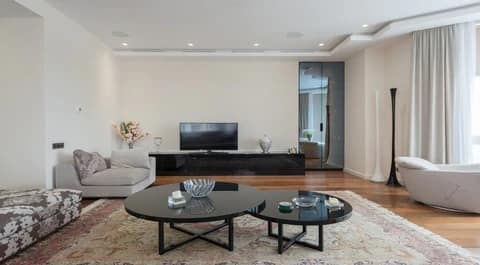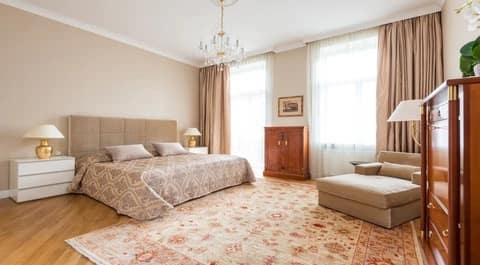Isfahan rugs are a type of Persian rugs that have been made in the city of Isfahan, Iran, since the 16th century. Like all Persian rugs, they are made by hand. However, they have some very distinctive features that stand out from other Persian rugs in terms of design and quality. Many people think that Isfahan rugs are the same as any other Persian rug, but if you read on, you’ll see why this isn’t the case!
This guide will provide everything you need to know about Isfahan rugs. We have all the information on their history, design patterns, and manufacturing technique. We will also share some tips to help you choose the perfect Isfahan rug for your home. So read till the end!
History of Isfahan Rugs
Isfahan (sometimes spelled Esfahan) is a city located in Iran. Also referred to as Nisf-e Jahan (Half of The World), it was once a capital for Safavid Empire. Safavids originated from the city of Ardebil in north Persia, which is now in present-day Azerbaijan. During their rule, arts and architecture flourished as never before. Moreover, the art of rug weaving reached its finest during this era. Safavids brought master weavers from Ardebil and Tabriz (a city that also served as the Persian capital) to Isfahan. These weavers teamed up with weavers from Isfahan to create masterpieces for the royal court.
The interaction between these expert weavers created new designs, patterns, and weaving techniques. Those designs and styles get their names after many kings from the Safavid dynasty. These ancient designs are still in use in carpet making industry in Iran. However, you can now find only the surviving few antique rugs in museums. But the legacy of fine rug making in the shape of Isfahan rugs is still alive.
How are Isfahan rugs different from other Persian rugs?
Though Persian rug is a general term for any carpet originating from Iran, there are specific variations within that category. Unlike many other Persian rugs, Isfahan rugs generally don’t feature geometric patterns. Instead, they use much more detail in their designs. These beautifully-woven rugs come in many colors but most commonly feature backgrounds of subtle earth tones such as beige, sand, or tan.
The ancient Isfahan rugs were created in the city of Isfahan. They are one of many styles produced during their period of greatest artistic fame, roughly during and after Safavid’s rule. The modern-day Isfahan rug style includes any Persian rug that employs Isfahani designs and patterns, regardless of origin. These carpets often feature medallion and extensive use of neutral colors like beige and ivory as background colors. A typical Isfahan rug design consists of a large central medallion or cartouche bordered by two columns of smaller roundels or symbols. These rugs have highly developed patterns, fine silks, and good wool quality.
Characteristics of Isfahan rugs
Isfahan rugs are among the most stunning rugs from Iran and the broader Persian rug world. They exhibit fine craftsmanship, elegant color combinations, and beautiful symmetry and designs. Let’s look at the characteristic colors, patterns, and weaving techniques of Isfahan rugs.
Materials used in Isfahan rugs
Weavers use different materials and their combinations in Isfahan rugs. These combinations can be wool on cotton, silk and wool mixture on cotton, silk and wool mix on silk, or luxurious silk on silk. Contrary to the misconception that Isfahan rugs use only wool or silk, some antique Isfahan rugs used cotton on cotton. However, the most common blend used in antique Isfahan rugs is a combination of wool and silk on a pure silk base.
In addition, high-quality wool for Isfahan rugs either comes from other provinces of Iran or from as far as Australia.
Weaving technique of Isfahan rugs
The ancient tribal weavers used their instinct to transfer the motifs and ornamentation that they had memorized by their repetitive usage in the Isfahan design rug. These days, a master designer first draws the design and pattern on a large paper. This template shows each color, shape, and Isfahani pattern in detail. The weavers use this template as a guide. It ensures the accuracy of execution of exact design in the weaving process from the beginning till the end.
A modern silk Isfahan rug typically uses a blend of silk and wool on a cotton foundation. If you visit carpet-weaving factories in Isfahan, you will be astonished to see hundreds of vertical looms busy weaving rugs to meet the high market demand of Isfahan rugs. It’s fascinating to know that Isfahan rugs are made totally by hand without a hook or tool. Isfahan rugs use the Persian style of knots, while the knot count in these rugs comes to 600 knots per square inch.
Patterns and colors in Isfahan rugs
Isfahan rugs use multiple vibrant color patterns on a light background such as ivory, beige, and cream. A modern Isfahan Persian rug usually has a light base and a combination of different shades of brown, red, blue, grey, and orange colors.
The Isfahan rugs of the Safavid times made for European dignitaries were first manufactured for the rulers of Poland. So, these rugs are referred to as Polonies rugs. These rugs caught the eye of other European notables because of their immense beauty. Polonies’ rugs used colors that were a match for European tastes. These colors include rose, bright green, turquoise, yellow, and orange.
As for patterns of Isfahan rugs, during the Safavid period, the most popular prints were floral with curvy patterns instead of geometric designs. During this time, many new motifs came into existence. Weavers named their motifs after different Safavid rulers and were made a part of Isfahan rugs that are still used today. Some popular Isfahani designs are Khatei design, Shaykh Safi design, and Shah Abbasi design.
7 Tips for Choosing Your Handmade Isfahan Rug
If you’re looking to add some charm to your home décor, consider buying a handmade Isfahan rug. Rugs are an excellent way to create personal style while adding comfort and warmth to your space. Handmade Isfahan rugs made from wool have been widespread across the globe since the beginning of rug-making history. However, finding one that’s right for you can be tricky. Follow these seven tips on how to choose handmade rugs. You’ll be well on your way to having a fantastic rug that stays beautiful and in place in your home for years and years to come!
1. Examine the material’s quality
The quality of a handmade rug can be difficult to judge. A rug generally uses wool, silk, or cotton, but finding information about its origin and materials may not be easy. For example, you might have to contact a retailer directly. And even if you ask your retailer some questions, they may not know everything there is to know about where their rugs come from. You can solve this uncertainty by Contacting ALRUG. We have authentic handmade Persian Isfahan rugs for sale, and we will answer all your queries and concerns regarding our rugs’ authenticity.
2. Verify the dye colors’ genuineness
If you’re looking to add a handmade Isfahan rug or any fine Persian rug to your home, it’s essential to know if you’re getting what you are paying for. Counterfeiters can copy them easily by using dye color and stitching similar to authentic carpets. On the other hand, handmade Isfahan rugs use organic dyes from plants or animals. Place a damp white cotton cloth on the carpet and rub gently to check the original colors. If the dye transfers to the fabric, the rug is machine-made with synthetic dyes and not genuine Isfahan rug.
3. Choose a design pattern that fits your style
Design isn’t a make-or-break factor when choosing a rug, but that doesn’t mean you should ignore it. Do you want a bold rug to set off your furniture? Or do you prefer something with soft colors and subtle patterns that blends in easily? We suggest choosing a design that appeals to your taste. It can help turn your new purchase into an heirloom!
There are many choices from tan, beige, ivory, red and blue Isfahan rugs. Select a subtle and minimal design with light colors for a contemporary look as it goes perfectly with many décor styles.
4. Vintage Isfahan rugs bring unparalleled style
Many people invest in handmade Isfahan rugs because they make a bold statement. They are proof of their owner’s appreciation of artistry and tradition. You can dress up any room with these artistic masterpieces. If you’re looking to bring some character into your home décor, these vintage beauties are a perfect place to start. No two handmade Isfahan rugs are alike. So, if you’re looking for something unique and outstanding to complement your other décor items, look no further than Isfahan rugs!
5. Select a color scheme that complements your home décor
Color is one of your primary ways to add a personal touch to your home. You can even create a cohesive look by choosing wall colors, furniture, and accessories that match your chosen rug. When in doubt, consider what changes you can make to ensure that the new rug Isfahan blends into your current décor. For example, you may find that a pattern is too bright or busy to suit the existing furnishings or art. If so, rethink your color scheme and go with something more subtle. After all, rugs should complement other elements in a room and not clash with them!
6. Examine the Isfahan rugs structure and weave from the back
You can see handmade knots and natural imperfections when you look at a handmade Isfahan rug from behind. The machine-stitched carpets don’t have these knots. Weavers often use modern, synthetic materials in their rugs because they’re cheaper and easier to work with. So if your rug looks all plastic from behind, it’s more likely not handmade and less expensive than you think.
Isfahan rug identifying becomes easy if you look closely at the rug’s fringe. In a handmade Isfahan rug, this fringe is the end part of the weaving threads. On the contrary, a machine-manufactured rug has a fringe stitched at the ends separately to give the feel of a handmade carpet.
7. Handmade Isfahan rugs are worth the investment
If you’re looking to buy a handmade Isfahan rug, it’s essential to consider what you are willing to pay for it. Depending on your budget, you can select a small size rug. Remember that rugs with braided borders are less expensive than hand-knotted options. Also, do remember that good handmade Isfahan rugs will last generations!
Price is one of the most critical factors in choosing a handmade rug. You want a great quality rug and want to make sure that you’re not paying too much. Also, if you can afford a high price tag on your handmade rug, then the choices are endless. However, it would be best if you try to get a deal without sacrificing quality and style. Take note of where and when it will be available at a discount. Check out our website to see if we are offering a discount on Isfahan rugs!
Source: https://alrug.com/blogs/rug-digest/isfahan-rugs






















